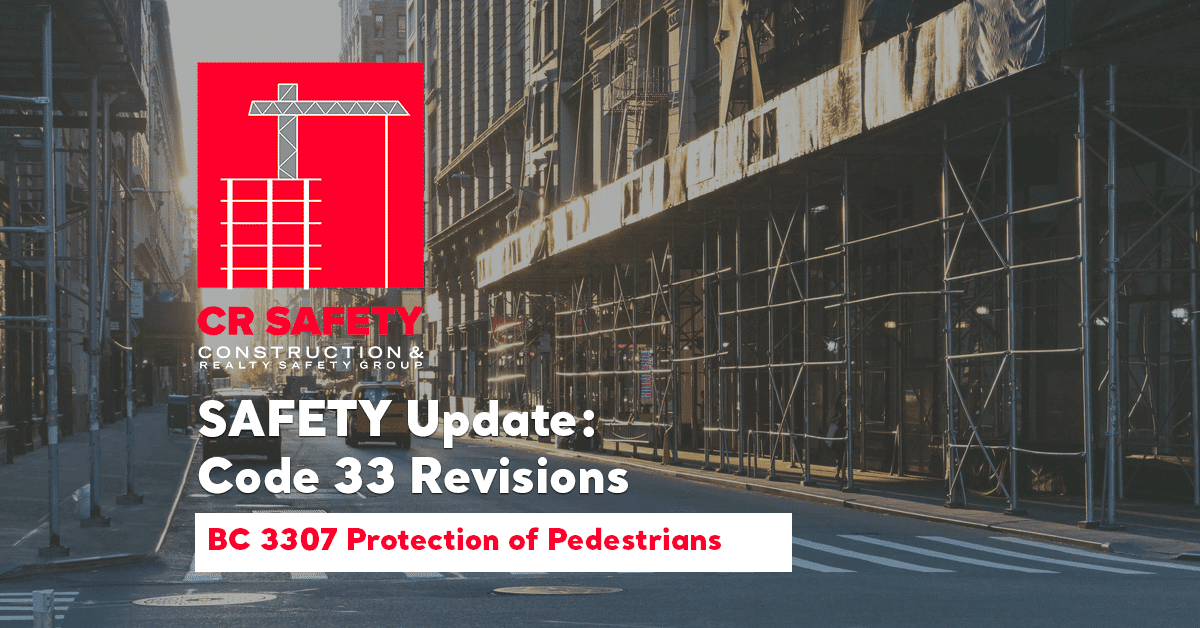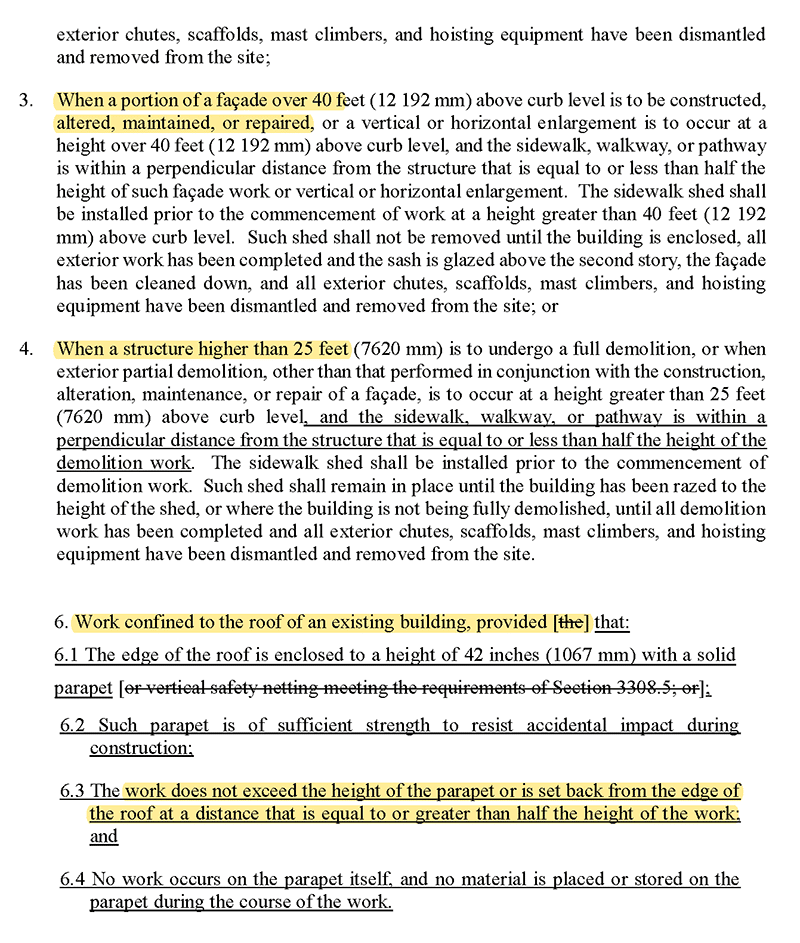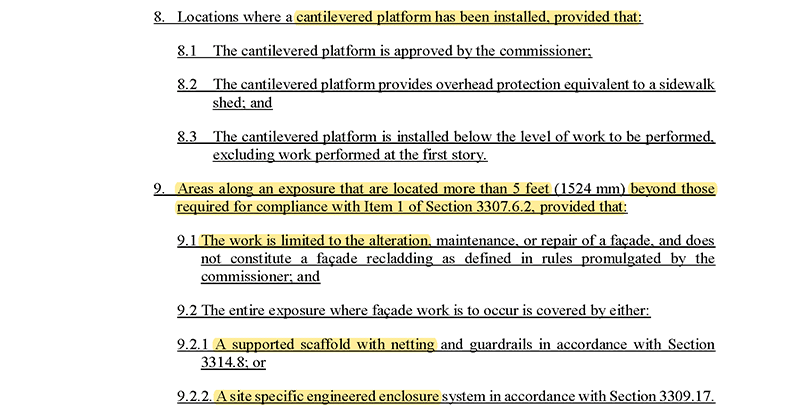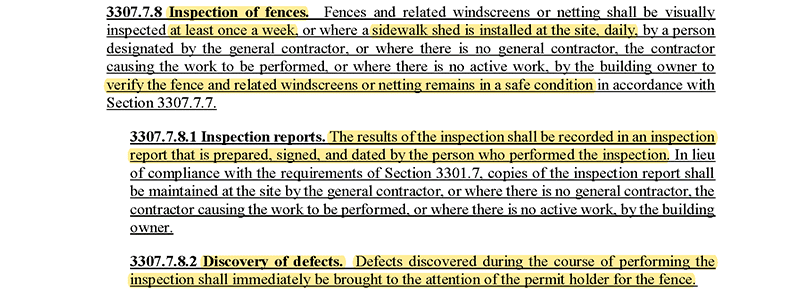In our SAFETY Updates series we’ll be sharing important revisions to NYCDOB’s Chapter 33 Construction Code – Safeguards During Construction or Demolition
BC 3307 – Protection of Pedestrians
The existing code required the protection of sidewalks and pedestrian walkways when overhead work was planned. The revised code added bicycle lanes as well. Protection shall be in accordance with DOT regulation. When a temporary walkway will occupy a bicycle lane and share that bike lane, DOT authorization is required.
You can see the revision here:
The revised code modified and added to some of the sidewalk shed exceptions, some as-of right and some requiring specific approval by DOB (i.e., variance/CCD-1).
Exemptions:
- Work confined to the existing roof of a building with a solid parapet of 42 inches (vertical netting no longer permitted) is exempt from sidewalk shed requirements, provided the work does not take place above the level of the parapet or if above, the work is set back from edge at least ½ the height or more of the highest work. (No CCD-1)
- Cantilever OHP of sidewalks is now allowed in lieu of a post-supported sidewalk shed (SWS), provided the loading requirements of a sidewalk shed are met (150/300 PSF, depending on height of building above sidewalk requiring the protection).
- For existing bldgs. 40 feet or less in height undergoing typical façade repair and enclosed by a supported scaffold [or site-specific engineered enclosure (3309.17)], the area of sidewalk/walkway beyond 5 feet from the supported scaffold face does not require a sidewalk shed. (CCD-1 Required). Remember, if the scaffold or equipment installation is in association with work that is covered by 3307.6.2, Paragraph 2, 3, or 4, it is those section that determine the coverage of the sidewalk shed deck. Basically, if you fall under those sections (NB or façade alteration greater than 40 feet or DM greater tan 25 feet), the sidewalk shed must cover the full width of the sidewalk, minus 18 inches at the curb to clear street furniture, trees, hydrants, DOT signs, etc.
The existing code provided an exception to the requirement for professional design of sidewalk sheds, provided the sidewalk shed conforms to an approved BSA standard. This exception has been removed from the revised code. Now all sidewalk sheds require professional design.
The revised code added a requirement for a 10-foot minimum spacing between vertical posts on sidewalk sheds (in the long direction) installed pursuant to major new building work. This will adversely impact sidewalk shed suppliers, as the current typical spacing is 8 feet. In addition, the horizontal bracing elements must be a minimum of 8 feet above the ground. The “Urban Umbrella” (the prototype design that won a city design competition) is exempt from this requirement.
The revised code now allows the sidewalk shed deck to be a translucent material. When translucent material is used, no storage is permitted.
Sidewalk shed parapets are now required to be galvanized wire screen, instead of solid wood. This will cut down on failures due to wind loading. The inclined braces for parapets must now be metal (which is common now). Parapets of sidewalk sheds used in conjunction with full or partial exterior demolition (except for façade repair/maintenance) must still be made of solid material.
Revisions have been made to the color requirements for sidewalk sheds. Solid parapets still need to be hunter green. Mesh parapets can be hunter green or metallic grey. Structural supports can be hunter green or metallic grey. One curious exception is that a sidewalk shed prototype that won a design competition recognized by the city can be white. There is only one such sidewalk shed: the so-called Urban Umbrella.
A new weekly inspection requirement was added to the new code for fences. Where a sidewalk shed is also installed at the site, both the sidewalk shed and fence need to be inspected daily. Documentation of all inspections must be kept on site. The color of the fence remains the same—hunter green, exception fences installed on sites with “Urban Umbrella” sidewalk sheds can be the same color as the SWS (white).
Should you have any questions about these safety code changes, give us a call at 212-736-6900 or email us at: info@crsafetygroup.com
You can find the Chapter 33 Safeguards During Construction OR Demolition General Section here…
You can find Local Law 126, authorizing the revisions of these building codes here…
A Full-Service Safety Management Firm
CR SAFETY offers full-service construction safety solutions, including on-site, professional safety management staffing, complete and customized Plan Program Development, and all required safety training.














